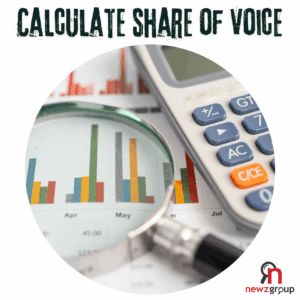
What is Share of Voice?
Share of Voice (SOV) measures your brand’s visibility compared to your competitors. It quantifies how much “space” your brand occupies across the different media channels.
In this blog we will outline how Share of Voice is calculated, and what tools are available to gather the information needed to determine your share of the market.
How to calculate Share of Voice:
To calculate Share of Voice (SOV), you need to determine your brand’s presence or mentions within a specific market or channel and compare it to the total presence or mentions of all competitors in that same space. The basic formula for calculating SOV is:
Share of Voice= (Your Brand’s Metrics / Total Market Metrics) × 100%
Here’s a breakdown of the components and how to apply this formula across different areas:
- Define What You’re Measuring:
The “metrics” you use will depend on the channel or aspect of your brand presence you want to analyze. Common areas include:
- Social Media: Number of mentions, likes, shares, comments, hashtag usage related to your brand versus competitors.
- Search (Organic): Visibility in search engine results pages (SERPs) for relevant keywords compared to competitors. This can be based on keyword rankings, organic traffic, or impressions.
- Search (Paid/PPC): Impression share of your ads compared to the total available impressions for relevant keywords.
- Print Mentions: Number of media mentions that occur for your keywords or topics in traditional newspaper publications.
- Broadcast Mentions: The number of mentions of a keyword or topic across Broadcast TV & Radio channels.
- Identify Your Competitors:
Clearly define your competitive set. This might include direct competitors offering similar products or services, as well as indirect competitors providing alternative solutions.
- Gather Your Brand’s Data:
Collect the relevant data for your brand for the chosen metric and time period. This might involve using social listening tools, SEO analytics platforms, advertising dashboards, media monitoring services, or web analytics.
- Gather Competitor Data:
Collect the same relevant data for your identified competitors for the same time period. This can sometimes be more challenging and may require using similar tools or publicly available information. Some tools offer features to track competitor performance directly.
- Apply the Formula:
Once you have your brand’s metrics and the total market metrics (your brand’s + competitors’), plug the numbers into the formula:
Example: Social Media Share of Voice
Let’s say your brand had 500 mentions on social media in the last month, and your three main competitors had 300, 450, and 250 mentions, respectively.
- Your Brand’s Mentions = 500
- Competitor 1 Mentions = 300
- Competitor 2 Mentions = 450
- Competitor 3 Mentions = 250
- Total Market Mentions = 500 + 300 + 450 + 250 = 1500
Your Brand’s SOV= (500/1500) × 100%=33.33%
This means your brand accounted for 33.33% of all social media mentions within your defined competitive set for that month.
Tools for Calculating Share of Voice:
Manually calculating SOV can be time-consuming, especially for large datasets. Fortunately, various tools can automate this process, including:
- Free Options:
- Manual process of counting and compiling the data you need for your brands and your competitors
- Google Analytics and Google Trends
- Paid Options through Media Monitoring providers
Gathering Data To Calculate SOV
Free Methods
Once you have have outlined what you are measuring, and the competitors/brands in your space, you will need to start collecting the data. There are some free resources available to get this process started.
Social Media:
- Platform Analytics: Most major social media platforms (Facebook, Instagram, X, LinkedIn, TikTok, YouTube) offer free built-in analytics dashboards for business or creator accounts.
- Your Brand’s Data: These platforms provide data on your post reach, impressions, engagement (likes, comments, shares), and sometimes mentions or hashtag usage related to your content.
- Competitor Data: While direct competitor data is limited, you can manually track their public profiles to note their engagement rates, posting frequency, and estimated reach (based on follower count). Some platforms might show top-performing posts or overall audience growth.
Free Monitoring Tools (Limited Functionality): Helps track basic brand mentions.
- Google Alerts: Set up alerts for your brand name and competitor names to receive email notifications of new mentions on the web (including some social media). While not not very customizable, it can provide a basic overview of the coverage for you and your competitors.
Comparison Tools:
- Google Trends is the easiest way to get basic online search comparisons between multiple search terms (your brand and multiple competitors brands).
- Compare up to 5 search terms at a time
- Filter results to worldwide results or results from a specific country or sub region
- Filter to a specific time range
Manual Process:
To get data for something specific, it will likely require a manual search and tally.
Limitations of Free Tools:
It’s crucial to understand that while these free tools can provide some basic data, they often have significant limitations:
- Limited Data: The amount of data you can access might be restricted.
- Less Granular Insights: The depth of analysis and specific metrics might not be available.
- Manual Effort: Collecting and comparing competitor data often requires significant manual work.
- Accuracy: Data gathered manually has human errors.
- Time-Consuming: Gathering and compiling data from multiple free sources can be very time-intensive.
Gathering Data To Calculate SOV
Paid Services
A paid media monitoring service offers significant advantages over free tools when it comes to calculating and understanding Share of Voice (SOV). Here’s a breakdown of what these services can provide:
- Comprehensive Data Collection Across Multiple Channels:
Wider Coverage: Paid services monitor a much broader range of online and offline sources, including social media platforms (often with deeper historical data access), news websites (including premium and paywalled content), blogs, forums, review sites, printed newspaper media, and even broadcast (TV and radio).
Real-time Monitoring and Alerts: They provide real-time or near real-time updates on mentions, allowing for timely analysis and response, which is crucial for accurate SOV calculations over specific periods. You can set up instant alerts for brand and competitor mentions.
Historical Data: Paid tools often store historical data, enabling you to analyze SOV trends over time, compare performance across different periods, and identify the impact of specific campaigns or events.
- Advanced Analytics and Metrics:
Automated Share of Voice Calculation: Many paid platforms have built-in SOV features or the ability to easily calculate it by tracking your brand mentions against competitor mentions within the platform. This saves significant manual effort.
Sentiment Analysis: These services often use AI-powered sentiment analysis to categorize mentions as positive, negative, or neutral. This adds a layer of qualitative understanding to your SOV, showing not just the volume of mentions but also the tone.
Reach and Impressions: Paid tools can often estimate the potential reach and impressions of mentions, providing a more sophisticated understanding of the visibility your brand and competitors are achieving.
Influencer Identification: Paid tools can help identify key influencers who are talking about your brand or your competitors, adding another dimension to your SOV analysis by considering the impact of these voices.
- Robust Reporting and Visualization:
Customizable Dashboards: You can create customized dashboards to track the specific metrics relevant to your SOV analysis, visualizing the data in charts and graphs for easier understanding.
Automated Reporting: Paid services often offer automated report generation, saving time and ensuring consistent tracking of your SOV. These reports can often be exported and shared easily.
Competitive Benchmarking: These tools allow you to directly compare your brand’s metrics (mentions, sentiment, reach, etc.) against your defined competitors within the platform, making SOV analysis more straightforward and insightful.
- Advanced Filtering and Segmentation:
Boolean Search Capabilities: Paid tools typically offer advanced search functionalities using Boolean operators (AND, OR, NOT) to refine your searches and ensure you are tracking the most relevant mentions for your brand and competitors.
Topic and Keyword Grouping: You can often group mentions by specific topics, products, or campaigns, allowing for a more granular SOV analysis for different aspects of your business.
- Dedicated Support and Integration:
Customer Support: Paid services usually offer dedicated customer support to help you set up your monitoring, understand the data, and troubleshoot any issues.
Integration with Other Tools: Many paid media monitoring platforms integrate with other marketing and PR tools, providing a more holistic view of your brand’s performance.
Conclusion
In summary, a paid media monitoring service provides a much more comprehensive, accurate, and insightful approach to calculating and understanding Share of Voice compared to free tools. They automate data collection across a wider range of sources, offer advanced analytics like sentiment and reach, provide robust reporting, and allow for more granular filtering and competitive benchmarking. While requiring an investment, these services can save significant time and provide valuable strategic insights into your brand’s position in the market.
Learn more about Share of Voice: https://blog.newzgroup.com/archives/14037
Learn more about Media Monitoring Services: https://www.newzgroup.com/media-monitoring-services/




